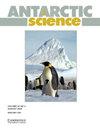基于场地特征的冰下湖融水源区预测
IF 2
4区 地球科学
Q3 ENVIRONMENTAL SCIENCES
引用次数: 0
摘要
冰下融化对冰盖动力学具有重要意义。定位和识别冰下湖泊既昂贵又耗时,需要雷达测量或卫星方法。我们利用七个对冰盖温度敏感或受其影响的全大陆环境特征,探索了三种确定湖泊源区的方法。将湖泊位置的环境特性与其整个大陆的分布进行简单的比较表明,稳定的湖泊位置与冰厚和表面温度之间存在统计关系(高Kolmogorov-Smirnov统计量),表明在被动条件下融化。相比之下,活动湖泊与直接热影响参数的相关性很小,而与水平速度和基岩高程的统计差异很大。更复杂的技术,包括主成分分析(PCA)和机器学习(ML)分类,提供了更好的湖泊类型空间识别。由环境特征得出的正PCA值与稳定湖泊相关,而负值对应于活跃湖泊。ML方法还可以识别可能存在冰下湖融水源的区域。虽然机器学习提供了最准确的分类地图,但这些方法的结合增加了对湖泊形成的主要控制因素和可能发现它们的环境设置的更深入的了解。本文章由计算机程序翻译,如有差异,请以英文原文为准。
Prediction of subglacial lake melt source regions from site characteristics
Abstract Subglacial melt has important implications for ice-sheet dynamics. Locating and identifying subglacial lakes are expensive and time-consuming, requiring radar surveys or satellite methods. We explore three methods to identify source regions for lakes using seven continent-wide environmental characteristics that are sensitive to or influenced by ice-sheet temperature. A simple comparison of environmental properties at lake locations with their continent-wide distributions suggests a statistical relationship (high Kolmogorov-Smirnov statistic) between stable lake locations and ice thickness and surface temperatures, indicating melting under passive conditions. Active lakes, in contrast, show little correlation with direct thermally influenced parameters, instead exhibiting large statistical differences with horizontal velocity and bedrock elevation. More sophisticated techniques, including principal component analysis (PCA) and machine learning (ML) classification, provide better spatial identification of lake types. Positive PCA scores derived from the environmental characteristics correlate with stable lakes, whereas negative values correspond to active lakes. ML methods can also identify regions where subglacial lake melt sources are probable. While ML provides the most accurate classification maps, the combination of approaches adds deeper knowledge of the primary controls on lake formation and the environmental settings in which they are likely to be found.
求助全文
通过发布文献求助,成功后即可免费获取论文全文。
去求助
来源期刊

Antarctic Science
地学-地球科学综合
CiteScore
3.60
自引率
6.20%
发文量
42
审稿时长
3 months
期刊介绍:
Antarctic Science provides a truly international forum for the broad spread of studies that increasingly characterise scientific research in the Antarctic. Whilst emphasising interdisciplinary work, the journal publishes papers from environmental management to biodiversity, from volcanoes to icebergs, and from oceanography to the upper atmosphere. No other journal covers such a wide range of Antarctic scientific studies. The journal attracts papers from all countries currently undertaking Antarctic research. It publishes both review and data papers with no limits on length, two-page short notes on technical developments and recent discoveries, and book reviews. These, together with an editorial discussing broader aspects of science, provide a rich and varied mixture of items to interest researchers in all areas of science. There are no page charges, or charges for colour, to authors publishing in the Journal. One issue each year is normally devoted to a specific theme or papers from a major meeting.
 求助内容:
求助内容: 应助结果提醒方式:
应助结果提醒方式:


